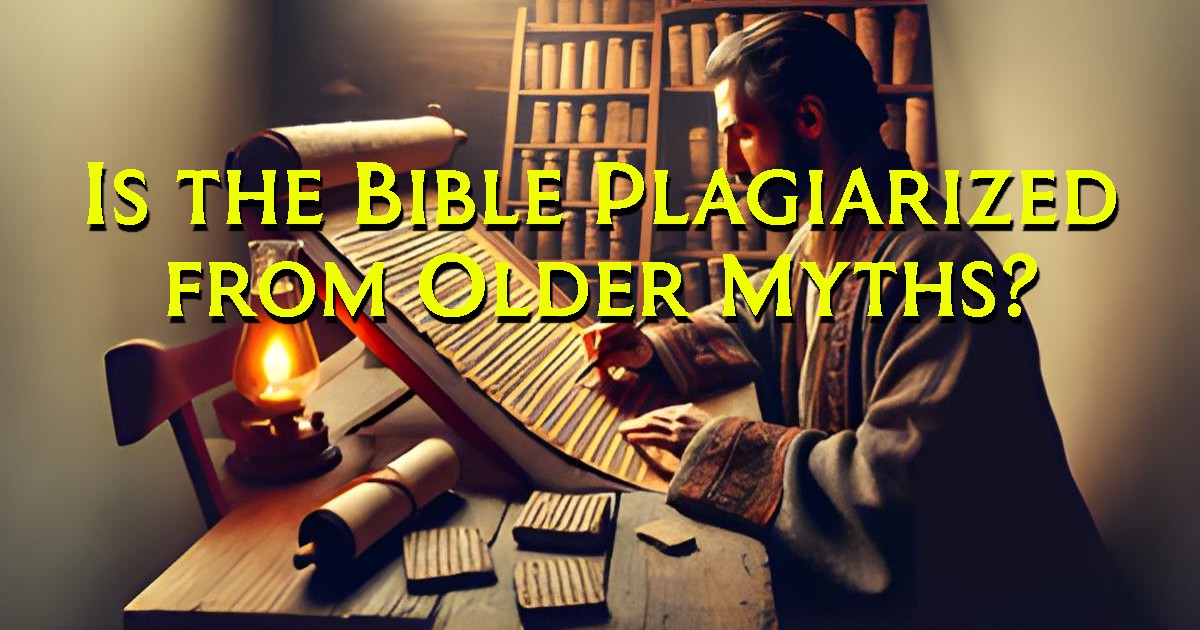Prepare to have your assumptions challenged.
For many believers, the Bible stands as the inspired Word of God—unique, sacred, and unparalleled. But what if I told you that the Bible shares striking similarities with ancient myths and texts that predate it by centuries, even millennia? Secular scholars have long studied these connections, raising the provocative question: Is the Bible plagiarized from older myths?
While “plagiarism” might be too strong a term (given the ancient world’s different concepts of authorship), the evidence suggests that biblical writers were deeply influenced by surrounding cultures. Let’s dive into the secular investigation of the earliest texts and uncover some surprising parallels.
The Flood Narrative: Echoes of Gilgamesh
The story of Noah’s Ark in Genesis 6-9 is one of the most iconic tales in the Bible. But did you know that a nearly identical story exists in the Epic of Gilgamesh, an ancient Mesopotamian text dating back to around 2100 BCE—well before the Hebrew Scriptures were written?
In the Gilgamesh epic, a man named Utnapishtim is warned by a god to build a massive boat to survive a catastrophic flood sent to destroy humanity. He gathers animals, family, and supplies. After the flood subsides, he sends out birds to find dry land. Sound familiar?
The striking parallels suggest that the biblical flood story may have been adapted from Mesopotamian sources, reflecting how stories evolved as they were passed down through generations and cultures.
Creation Stories: The Enuma Elish Connection
Genesis 1 describes the creation of the world in a majestic, orderly sequence. However, the Enuma Elish, a Babylonian creation myth from around 1800 BCE, contains eerily similar elements.
In the Enuma Elish, the god Marduk defeats the chaos goddess Tiamat and forms the heavens and earth from her divided body. Like Genesis, it depicts creation emerging from chaos, with light, sky, land, and celestial bodies appearing in sequence.
While Genesis presents a monotheistic and orderly view, the structural and thematic similarities hint at shared cultural roots, reworked to fit the theological vision of the Israelites.
Wisdom Literature: Borrowing from Egypt and Mesopotamia
Books like Proverbs, Ecclesiastes, and Job are part of the Bible’s wisdom literature. Yet, they mirror earlier texts from Egypt and Mesopotamia. For example:
- The Instruction of Amenemope (Egyptian, c. 1300 BCE) contains teachings nearly identical to parts of Proverbs 22-24. Scholars have found direct parallels in phrasing and structure, suggesting the biblical authors were familiar with Egyptian wisdom traditions.
- The story of Job, grappling with divine justice and human suffering, resembles Mesopotamian texts like the Babylonian Theodicy (c. 1000 BCE), where a man debates the meaning of suffering with a friend.
These connections reveal that biblical wisdom literature was part of a broader intellectual tradition, borrowing and adapting ideas from neighboring cultures.
The Law Codes: Hammurabi’s Precedent
The laws given to Moses in the Torah, especially in Exodus, Leviticus, and Deuteronomy, are central to Jewish and Christian ethics. However, they bear remarkable similarities to the Code of Hammurabi (c. 1754 BCE), one of the oldest known legal codes from ancient Babylon.
Both contain laws about property, justice, family, and even “an eye for an eye” (lex talionis). The biblical laws, though distinct in their theological framing, reflect legal principles already established in ancient Near Eastern societies.
Canaanite Influence: Syncretism in the Hebrew Bible
Archaeological findings and textual analysis suggest that early Israelite religion wasn’t strictly monotheistic. The Bible itself references deities like Baal, Asherah, and even El (a name also used for God in the Old Testament). In fact, “El” was a chief god in the Canaanite pantheon.
The theory of Canaanite syncretism proposes that Israel’s worship of Yahweh evolved alongside, and sometimes intertwined with, Canaanite religious practices. For instance, the poetic imagery in Psalm 29, often attributed to Yahweh, resembles Canaanite hymns dedicated to Baal.
A Mosaic, Not a Monolith
So, is the Bible plagiarized? Not exactly. It’s more accurate to say that the Bible is a mosaic of ancient stories, laws, and wisdom, reinterpreted through the lens of Israelite faith. Biblical authors weren’t copy-pasting texts; they were engaging with the cultural and religious ideas around them, crafting new narratives to express their unique relationship with the divine.
For believers, this doesn’t have to diminish the Bible’s significance. Instead, it reveals a richer, more complex tapestry of human history and divine inspiration, shaped over time and across civilizations.
Sources:
- The Epic of Gilgamesh (c. 2100 BCE)
- Enuma Elish (c. 1800 BCE)
- The Instruction of Amenemope (c. 1300 BCE)
- Code of Hammurabi (c. 1754 BCE)
- The Babylonian Theodicy (c. 1000 BCE)
- Archaeological studies on Canaanite religion and Israelite syncretism

